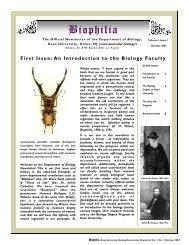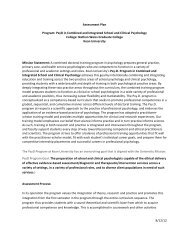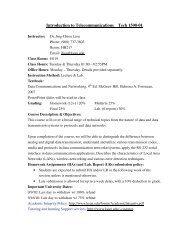GeorGe SeGal - Kean University
GeorGe SeGal - Kean University
GeorGe SeGal - Kean University
You also want an ePaper? Increase the reach of your titles
YUMPU automatically turns print PDFs into web optimized ePapers that Google loves.
with Mondrian’s Composition, 1933, on an Easel, 1965. these are a collector, an art dealer, an<br />
artist, and an arts patron.<br />
In truth, Segal steered away from formal commissioned portraits, and they form but a small<br />
part of his body of work:<br />
…It would be relatively simple using this method [plaster casting] to make<br />
uncannily accurate portrait sculpture. Mostly portrait sculpture is aimed at<br />
putting the sitter’s best foot forward and most sitters who are paying hard cash<br />
for a portrait are not interested in psychological probing. I suppose that’s the<br />
reason I avoid straight sculptures as much as I can, unless the person posing<br />
for me is willing to accept my particular kind of treatment (which is generally<br />
kind, but not glorifying). 2<br />
A second category of depiction—and in terms of portraiture perhaps much more controversial,<br />
given the artist’s stated intentions—would be that of persons not referred to in titles but known to<br />
the viewer through secondary sources. If we happen to look through the 1979 Walker Art center<br />
(Minneapolis) catalog for George Segal: Sculptures, one would learn that the then Director of the<br />
Walker, Martin Friedman, posed as the customer in Segal’s Hot Dog Stand. Friedman’s account<br />
of that experience (“A coat of nivea cream, a lubricant, was smeared over my hands and the<br />
chest area exposed by the open shirt….”) is part of the exhibition catalog. that decidedly<br />
changes how we see the sculpture: the humble “customer” is a museum director!<br />
More dramatically, since it is Segal’s first full-scale tableaux, is The Dinner Table 1962.<br />
the models include the now well-known artist Lucas Samaras, Kaprow and the dance critic<br />
Jill Johnston. Segal is quoted as saying: “I usually make sculpture of people I know very well in<br />
situations that I’ve known them in…as long as there has been a very alive emotional experience<br />
between me and the person.” Given the history of the artist’s friendships, this would certainly<br />
apply to The Dinner Table, for these are precisely the people that might be visiting Segal at his<br />
new Jersey chicken farm during that period. the viewer might not know or care who robert<br />
and Ethel Scull were, but it might be of interest to note that Samaras and Kaprow were friends<br />
and models. then, if you happened to have met one of the artists, as I have, another level opens<br />
up. Jill Johnston, of course, I knew well, since she was the dance critic at The Village Voice<br />
where I also worked.<br />
And then there is the third level of portraiture, which is recognized only by a very few, in<br />
Segal’s case a kind of unintended portraiture attained by and seen by family, friends not in the<br />
public eye, and perhaps the intimates of a very occasional professional model. Works with first<br />
names in their titles would be closer to portraiture than those without, since specific persons<br />
2 Phyllis tuchman, George Segal, Abbeville Press, 1983<br />
5

















